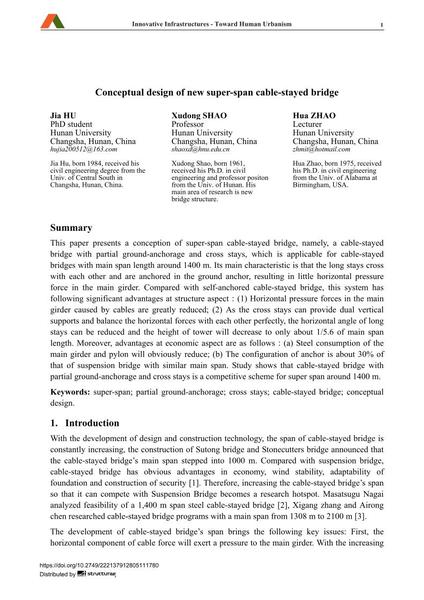Conceptual design of new super-span cable-stayed bridge

|
|
|||||||||||
Bibliographic Details
| Author(s): |
Jia Hu
Xudong Shao Hua Zhao |
||||
|---|---|---|---|---|---|
| Medium: | conference paper | ||||
| Language(s): | English | ||||
| Conference: | 18th IABSE Congress: Innovative Infrastructures – Towards Human Urbanism, Seoul, Korea, 19-21 September 2012 | ||||
| Published in: | IABSE Congress Seoul 2012 | ||||
|
|||||
| Page(s): | 1296-1302 | ||||
| Total no. of pages: | 7 | ||||
| DOI: | 10.2749/222137912805111780 | ||||
| Abstract: |
This paper presents a conception of super-span cable-stayed bridge, namely, a cable-stayed bridge with partial ground-anchorage and cross stays, which is applicable for cable-stayed bridges with main span length around 1400 m. Its main characteristic is that the long stays cross with each other and are anchored in the ground anchor, resulting in little horizontal pressure force in the main girder. Compared with self-anchored cable-stayed bridge, this system has following significant advantages at structure aspect:(1) Horizontal pressure forces in the main girder caused by cables are greatly reduced; (2) As the cross stays can provide dual vertical supports and balance the horizontal forces with each other perfectly, the horizontal angle of long stays can be reduced and the height of tower will decrease to only about 1/5.6 of main span length. Moreover, advantages at economic aspect are as follows:(a) Steel consumption of the main girder and pylon will obviously reduce; (b) The configuration of anchor is about 30% of that of suspension bridge with similar main span. Study shows that cable-stayed bridge with partial ground-anchorage and cross stays is a competitive scheme for super span around 1400 m. |
||||
| Keywords: |
cable-stayed bridge conceptual design super-span partial ground-anchorage cross stays
|
||||
